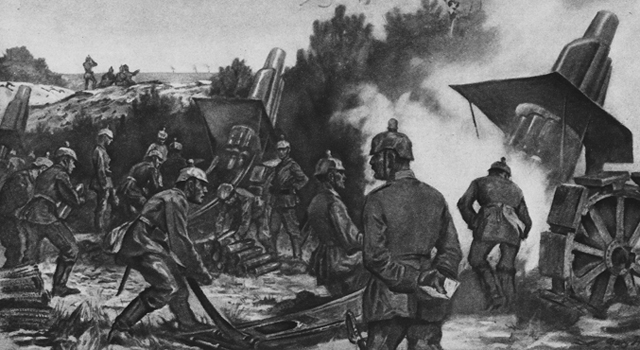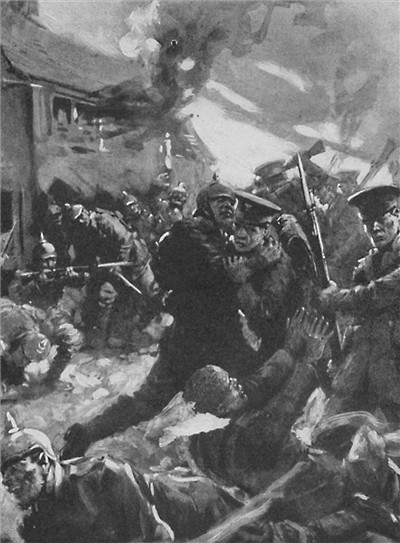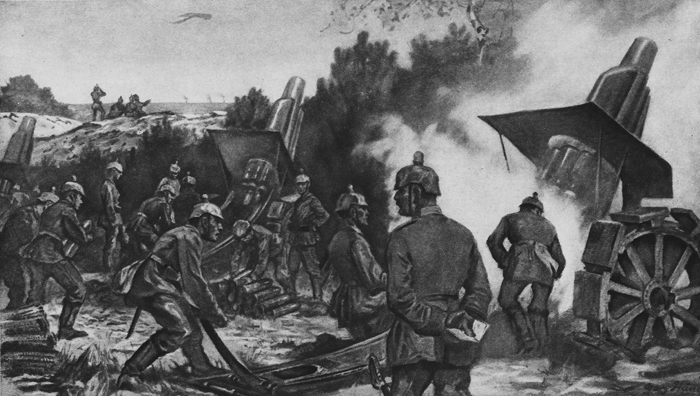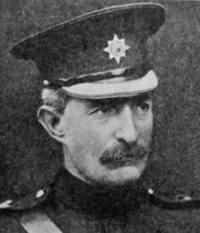Articles

12 Comments
By Voices
On 25, Nov 2014 | 12 Comments | In Frontline | By Voices
The Recapture of Gheluvelt, 31 October 1914
Dr Spencer Jones, University of Wolverhampton
The First Battle of Ypres
In October 1914 the British Expeditionary Force (BEF) was locked into a battle for survival. Fighting alongside her French and Belgian allies, the British Army sought to hold off a massive German offensive that aimed to capture the last sliver of unoccupied Belgium before driving onwards towards the strategically vital Channel ports of Dunkirk and Calais.
The initial German objective was the city of Ypres, which served as an important hub for the rail and road network in the area. Allied forces recognised the value of Ypres and resolved to defend it at all costs. The stage was set for the First Battle of Ypres. The engagement was prolonged, bitter and bloody. Proportionately, it was the costliest battle fought by the British Army in the entire First World War. Victory and defeat hung by the slenderest of margins.
The battle would prove to be a watershed. It was the transition point between the mobile, open warfare of August and September 1914 and the trench deadlock that would characterise the fighting between 1915 and 1917. At First Ypres, the French still worn their colourful blue and red uniforms and barbed wire was a novelty, but there were signs of the war to come. German artillery unleashed bombardments of unprecedented ferocity, whilst British rifles and machine guns took a heavy toll on infantry rushing forward in frontal attacks. The imbalance between entrenched defenders and attackers moving forward in the open was increasingly clear. The trenches at this stage were little more than ‘scrapes’, hastily constructed using whatever tools were available, and bore no resemblance to the complex networks that would emerge later in the war. They offered some protection from bullets and shrapnel but could be demolished by a direct hit from a shell.
As the battle wore on the infantry dug ever deeper in an attempt to protect themselves from the ferocious fire that swept the battlefield. Autumnal Flanders rain flooded trenches and made life a misery, and the continuous fighting between October and November meant that there was no possibility of relief or rotation: most British infantry battalions would spend a full month engaged in battle without rest. As one officer recalled ‘the line that stood between the British Empire and ruin was composed of tired, haggard and unshaven men, unwashed, plastered with mud, many in little more than rags.’
The ferocious fighting raged from the Channel coast in the north to Messines Ridge in the south, and even beyond. It was the first truly Allied battle of the war. Belgian, British, French, Indian and Algerian soldiers fought side by side to stem the tide of the German advance. The Allies were outnumbered, outgunned and overstretched. The Germans, drawing upon a fresh pool of manpower provided by the mass of volunteers that had joined the colours in August 1914, possessed a striking numerical advantage. Although these new soldiers lacked the level of training possessed by pre-war formations, the Germans sought to offset this advantage by supporting them with a mass of heavy artillery. The sheer weight of fire from these guns would batter down the Allied defences and allow the infantry to surge over the devastated trench lines.
The British Expeditionary Force had little answer to the weight of artillery fire possessed by the Germans. However, the British advantage lay in the quality of its officers and men. Made up almost entirely of pre-war regular soldiers, the BEF was a highly professional army that benefited from a very high standard of training. The army placed a tremendous amount of emphasis on rifle marksmanship. Every soldier was required to pass the ‘mad minute’ exercise, where the soldier was required to fire 15 rounds in 60 seconds at a target 300 yards away. Excelling at this test was considered the true mark of a soldier and many veterans could manage 20 rounds per minute or more. The army record, set in January 1914, was an astounding 38 shots in 60 seconds, all of which hit the inner ring of the bullseye.
There was thus a certain balance of power to the battle. The Germans enjoyed the advantage of heavy artillery support and superior numbers, whilst the British had the edge in training and possessed exceptional rifle skills. Repeated German assaults had smashed into the thin khaki line, buckling it, but never breaking it.
Nevertheless, by the end of October the iron law of attrition threatened to crush the BEF. The army was small and reinforcements few. Every German attack, even if repulsed, cost the British casualties. Replacing these highly trained men was almost impossible. Slowly, but surely, the BEF line was becoming thinner and thinner. It was in these circumstances that the Battle for Gheluvelt would take place.
The Battle for Gheluvelt

Gheluvelt was a small village with a pre-war population of just over one thousand people. However, its location astride the Menin to Ypres road gave it great strategic value in 1914. The road cut through surrounding woodland and provided the quickest and most direct route to Ypres. The German offensive towards the city sought to drive along this road, but Gheluvelt served as an obstacle to the advance. Outflanking and avoiding the village was impractical due to the dense woodland that lay on either side. Faced with these problems, the capture of Gheluvelt became a key German objective, and a formidable force of infantry, cavalry and artillery was assembled for the task. Recognising the strategic value of the hamlet, the British were determined to defend the village at all costs.
The British position was gravely overstretched and the line defending Gheluvelt was hard but brittle. Although made up of experienced officers and veteran soldiers, the defenders were few in number and had been exhausted by weeks of constant fighting. The British had no fall-back position and the only reserves available were the 2nd Worcesters, a single battalion that had already been reduced to half strength by the prolonged battle. If the line was broken then the road to Ypres, four miles beyond Gheluvelt, would be thrown open to the Germans. Senior commanders were well aware of the danger but the fighting was so ferocious and British numbers so few that they could do nothing more to strengthen the defences.
Against this perilously thin line the Germans had assembled a powerful assault force of several divisions backed by a startling concentration of artillery firepower. The plan was simple. A devastating preparatory bombardment would crush the British line, allowing the assault infantry to sweep through the ruined trenches and beyond into the open country.
 The Battle of Gheluvelt began at 6.00am on 31 October 1914. As planned, the Germans opened a ferocious bombardment with their artillery and followed it with a massed infantry advance. The British defenders gritted their teeth and repulsed this initial assault, but the Germans regrouped and, under the cover of the heaviest barrage of the battle thus far, attacked once more. The sheer weight of the attack was too much for the thin British line. It first cracked and then crumbled as the Germans poured through. The fighting was close ranged and desperate; many British units fought to the last man. To give but one example, at the end of the bloody day the 1st Queen’s mustered just two officers and 13 men from a paper strength of 1000 soldiers.
The Battle of Gheluvelt began at 6.00am on 31 October 1914. As planned, the Germans opened a ferocious bombardment with their artillery and followed it with a massed infantry advance. The British defenders gritted their teeth and repulsed this initial assault, but the Germans regrouped and, under the cover of the heaviest barrage of the battle thus far, attacked once more. The sheer weight of the attack was too much for the thin British line. It first cracked and then crumbled as the Germans poured through. The fighting was close ranged and desperate; many British units fought to the last man. To give but one example, at the end of the bloody day the 1st Queen’s mustered just two officers and 13 men from a paper strength of 1000 soldiers.
With the line broken, the Germans surged forward and soon reached the village of Gheluvelt. The hamlet had been hammered by shelling and as a result was ruined and ablaze. A handful of British survivors, primarily men of the South Wales Borderers, clung on in the grounds of a chateau to the east of Gheluvelt. The Germans, elated at their apparent victory, slowed their advance to deal with this stubborn remnant. It would prove to be a fatal mistake.
The defenders at the chateau were fortunate in that they possessed an unbroken telephone line that ran to the headquarters of 1st Guards Brigade to the north. The brigade was commanded by Charles FitzClarence VC, a formidable Irishman who had earned the nickname ‘The Demon’ for his ferocity in battle. Informed of the situation at the front, he resolved that the only option was to make an immediate counterattack. Gheluvelt must be retaken. Timing was of the essence. The Germans had paused to deal with the chateau, but this distraction would not occupy them for long. The British counterattack had to be made immediately.
 FitzClarence discovered the 2nd Worcesters and their commander Major Edmund Hankey at the edge of the battlefield. FitzClarence had no formal authority over Hankey, whose unit belonged to a different division, but commandeered the unit due to the gravity of the situation. A 20-minute long briefing followed as FitzClarence outlined the situation before giving Hankey a formal order: ‘Advance without delay and deliver a counter-attack with the utmost vigour against the enemy, who were in possession of Gheluvelt.’
FitzClarence discovered the 2nd Worcesters and their commander Major Edmund Hankey at the edge of the battlefield. FitzClarence had no formal authority over Hankey, whose unit belonged to a different division, but commandeered the unit due to the gravity of the situation. A 20-minute long briefing followed as FitzClarence outlined the situation before giving Hankey a formal order: ‘Advance without delay and deliver a counter-attack with the utmost vigour against the enemy, who were in possession of Gheluvelt.’
The duty was an unenviable one. Hankey’s force consisted of just 8 officers and 370 men and would have to cross a stretch of entirely open ground to reach the burning village. Once there, they would have to force the Germans out at the point of the bayonet. It is unclear how many German soldiers occupied Gheluvelt at this stage, but they certainly outnumbered the Worcesters by a considerable margin.
At approximately 2.00pm the Worcesters began their advance with Hankey leading from the front. His terse memories of the attack were ‘deafening noise – retreating men – shouting commands’. He and his soldiers ran across the open ground, passing underneath a hail of German shrapnel that inflicted over one hundred casualties on the small force. Yet a combination of the pace of the attack, the thick smoke that clouded the battlefield and the fact that the Germans were concentrating their efforts on engaging the survivors at chateau meant that the enemy infantry did not see the Worcesters until it was far too late. Bursting through the smoke and surging into the village, the British set about the surprised Germans with bayonets and rifle butts. A German survivor remembered hearing the cry of ‘The British have forced their way back in!’ over the din of battle. The surprise was complete. The Germans, perhaps believing they were being attacked by a far larger force, were routed from the village in short order. The Worcesters linked up with the survivors at the chateau and nervously held the line, expecting the Germans to return at any moment. The fears were unfounded. The rout had been complete and the Germans were incapable of making any further attacks. In the early evening, conscious that they his men could not hold the position indefinitely, FitzClarence ordered his troops to abandon the devastated village and withdraw to a new defensive line at Veldhoek.
The recapture of Gheluvelt stopped the German advance dead in its tracks and prevented a complete breakthrough. British commander in chief Field Marshal Sir John French commented that the 2nd Worcesters had ‘behaved with the utmost gallantry’. Such was the intensity and confusion of battle that French was initially unable to uncover the full details of the counterattack. It was only weeks later that he was able to gather statements that revealed how FitzClarence had taken charge and ordered the 2nd Worcesters to retake the village.
Although it was not immediately apparent to embattled officers and men, the recapture of Gheluvelt was the tipping point of the First Battle of Ypres. The great assault of the 31 October represented Germany’s best chance to win a decisive victory and capture Ypres itself. Fierce fighting continued for another three weeks after the struggle for Gheluvelt, but the Germans, bloodied by their losses and exhausted by their efforts, never came so close to a decisive breakthrough again.
Images from the private collection of Dr Spencer Jones:
Image 1: British and German soldiers locked in hand-to-hand fighting in the streets of Gheluvelt.
Image 2: German heavy howitzers in action. Guns such as these had a devastating effect on the British defences.
Image 3: Brigadier-General Charles FitzClarence VC. His decision to launch an immediate counterattack to retake Gheluvelt proved decisive.
-
Thank you for this interesting article. My Great Grandfather, Private Arthur Tickner, was one of the many men from 1st battalion Queen’s West Surrey who lost his life on 31/10/1914 at Gheluvelt. Have there been any war graves located for this battle, as there is no known grave for my great grandfather, he is however recorded on the Menin Gate.
Private Arthur Tickner (Also known as Arthur Weller) 1885-1914, a coal carter from Dorking, Surrey. Husband of Elizabeth, father of Constance, Beatrice, Clarice, Arthur and finally Phyllis who was born eight weeks after he died.
-
Hi Imogen,
Our great grandfather, Walter Mead, was also in the same regiment and died on 31st October at Gheluvelt. He was a tailor from Morden, when it was part of Surrey.
We have just some back from Ypres and a visit to the Menin Gate. Whilst there, we discovered that you can apply to lay a wreath in memory of a soldier who died defending Ypres. Info is here:
http://www.greatwar.co.uk/events/menin-gate-last-post-ceremony.htm
You may well have already discovered this, but if not, I hope it helps.
All the best, Julie. -
A distant cousin of mine John Dopping Boyd of the Surreys, then a 2nd Lieutenant, led a guerrilla force to cover the eventual retreat from Gheluvelt of the Worcesters and allied groupings.
I would love to know more of the story of these men, as while he was Anglo Irish (as opposed to our family being Gaelic Irish), the spirit of this grouping is right out of the Gaelic “toraigh” or raparee tradition, what would be a commando grouping in formal military terms. Indeed it could be called an example of “Derring do!”
I have been corresponding with Spencer Jones on this issue, but getting in direct contact with other families of those who fought may give an even better history.
-
-
Hi Imogen – I visited Gheluveldt on 11 November 2017 to see where the 2nd Worcesters started their charge. I cannot get over the bravery of the officers and men who confronted such fearsome odds. Whilst there I met a Belgian gentleman who spends most of his life researching British soldiers who fell for their country – and from what he said I dont think he charges huge fees, if any !) If you would email me (paulbenn@eircom.net) I will dig out the card he sent me and pass on his details. (I just came out of hospital yesterday after a spinal operation and I dont have his details to hand but will easily find them for you.). Incidentally the Earl Haig’s Own Pipe Band played at the 11/11/2017 service, in addition to myself and a relative there were about 6 other British and some 20 Belgians so nothing is forgotten, the fallen are remembered. Best wishes, Paul
-
Thanks for all the information about the battle
I know my Great Uncle was killed there and was in the 2nd Dragon Guards (Queens Bays) 4685
His body was never found it was thought he was wounded and sent to the hospital tent which was then shelled .
As the previous comment said his name is also on the wall -
You will find that 1st South Wales Borderers had not been driven out of the chateau and were still holding when 2nd Worcesters came up. The Worcesters did not ‘recapture’ Gheluvelt; they arrived to the support of 1 SWB and they jointly held the ground thereafter. Sir John French later admitted that he was unaware that 1 SWB was still holding when he wrote the salient despatch, which is why the matter is sometimes misinterpreted. Both regiments exchanged greetings telegrams on the anniversary ever after; a tradition that continued through the days of the RRW and WFR and happened again only yesterday, between the modern day Royal Welsh and the Mercian Regiment. With best wishes. M
-
My Grandfather was Regimental Sergeant Major South Wales Borders James Shirley.
Professional soldier from age 16. Boer War, 1st guns of August, served in Egypt, Palistine, India and China. Re joined in WW 2. He is in the famous painting of the battle that hangs in the Worsters officers mess. Very proud. -
I just acquired an antique hip flask that has the engravings
“T.E. Pleydell-Bouverie
K.R.P.C
Gheluvelt October 1914”
May be of interest to some folks here
Kind regards
Gary Tan
Curator
The Retro Factory
Singapore-
I believe that this would be Jacob Edward Playdell – Bouverie who died the next day from wounds he received at Gheluvelt on the 31st of October 1914. He was a Lt in the 2nd Battalion Kings Royal Rifle Corps. Same as my grandfather who also died there on the same day.
-
-
My Great Uncle, Private Frank Alfred Creed was born at Emanuel, Sussex and enlisted at Bexhill. He was a pre-war regular soldier who joined the Royal Sussex Regiment in late 1907/early 1908 by his regimental number. On the outbreak of war he was serving with the 2nd. Battalion Royal Sussex Regiment, Part of 1st. Division and went to France with them on 12th. August 1914. He took part in the Retreat from Mons, the fighting on the Aisne and the First Battle of Ypres. He was killed in action on 31st. October 1914 when his unit was defending the ground south-west of Gheluvelt. He is commemorated on the Menin Gate Memorial, Ypres.
-
My great uncle 4290 Pte Arthur John Hiscox fell in this battle on 31 October 1914.
Although not mentioned in the above transcript he was with the 1st Battalion Coldstream Guards -
Have just discovered from my paternal grandfather’s pen record that he was wounded in action (GSW to left calf) I’m defence of the GHELUVELT CHATESU during first battle of YPres on 01.11.1914. 1st bttln Scots Guards 2688038.Hosptalised no 7 General Hospital, Boulogne. 03.11.1914 admitted to 3rd (London General hospital Wandsworth discharged on 30.11.2014 returned to duties on 08.02.1915. So pleased I found this and fascinating albeit brutal account of events of which my grandad played a part and managed to survive. GBNF
Submit a Comment



Comments